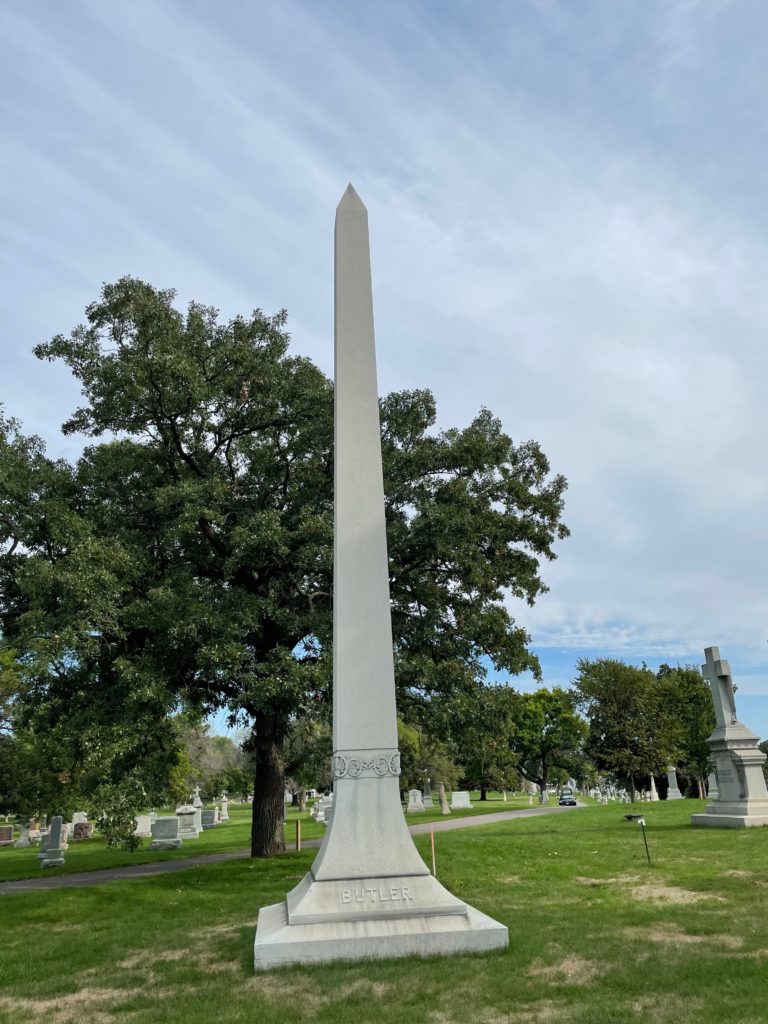Erik Visits an American Grave, Part 986
This is the grave of Pierce Butler.

Born in 1866 in Waterford, Minnesota, Pierce Butler was the child of Irish immigrants making a good of it on the Minnesota prairie. Not sure how much better that really was than Ireland. In any case, they had a bit of success and their son Pierce could go to college, which he did at Carleton College. He then passed the bar in 1888, choosing to stay in St. Paul rather than go back home.
Butler had ambition. He ran for county attorney in Ramsay County and won in 1892, serving two two-year terms. In 1896, he went back into private practice at an elite St. Paul law firm, where he basically was James J. Hill‘s railroad lawyer. Given how crooked these railroad capitalists were (even one slightly less notorious as Hill), you know you had to be a successful lawyer to handle that craziness. Most of Butler’s brothers ended up in the law too and in the early twentieth century they started their own firm that Pierce joined too. Basically, this was an extremely successful Minnesota lawyer, enough so that he was named president of the Minnesota State Bar Association in 1908. Interestingly, in 1912, he started spending most of his time in Canada and stayed for the next decade, handling government railroad law and winning large sums of money for his clients, whether shareholders or the government.
As one might expect from a Gilded Age corporate lawyer, Butler was a complete reactionary. That really came to the forefront during World War I, when he argued that professors at the University of Minnesota who did not support the war or were “radical” should be fired. He had real power too–he was a regent for the University. With these kinds of thoughts and history, it’s hardly shocking that in 1922 Warren Harding tapped Butler to be on the Supreme Court. It was hard to find a bigger corporate hack than Butler. The funny thing is that Butler was a Democrat. But what difference did it make? It’s not as if there were meaningful political divisions between Harding and Butler. It’s also worth noting that when people today worship in front of their bipartisanship fetish, this is what they are nostalgic for–reactionary Republicans and reactionary Democrats working across the aisle to implement reactionary polices. Yay!
Now, Butler’s nomination did receive significant opposition for that time period. Progressives in both parties were outraged that such a reactionary would be placed on the Court. Organized labor hated him. Progressive magazines such as The Nation and The New Republic called for his reaction. The University of Minnesota’s professors made a huge stink about how awful Butler was. Of course the Ku Klux Klan also hated him because Butler was Catholic. He was still confirmed 61-8. This was not a time when senators routinely voted down nominees. But the best people voted against him–Robert LaFollette, Peter Norbeck, George Norris.
Would Butler change his reactionary ways on the Supreme Court? Oh god no. He was an arch-reactionary. He joined the Court’s conservative bloc to stand in the way of any kind of progress. It wasn’t long after he joined the Court that they had to decide Adkins v. Children’s Hospital, which was whether a minimum wage in Washington, D.C. was constitutional. Of course, Butler joined the decision that it was unconstitutional. A minimum wage? That’s getting in the way of corporate freedom! In U.S. v. Schwimmer, he wrote the decision that ruled that an immigrant could be denied citizenship for saying they would not take up arms for their new country, this against a woman and a pacifist from Hungary.
Butler’s all-encompassing hatred of economic regulation only strengthened after Franklin Delano Roosevelt became president in 1933. The Court was filled with his type and they refused to retire, even though they were ancient. In fact, FDR got not a single nominee in his first term. By 1937, the so-called Four Horsemen, the reactionary core of the Court, which was Butler, James McReynolds, George Sutherland, and Willis Van Devanter, were so awful that Roosevelt issued his legendary court-packing scheme. He paid a real political price for it, but it also had its intended effects of moving the swing votes to the left and convincing some of the dinosaurs to retire. But not Butler. He hated FDR. So he just stayed on. In fact, he never retired. He voted against the constitutionality of every single piece of New Deal legislation that came before the court. Balls and strikes, amirite?
There are a couple of issues on which Butler was not terrible, mostly around civil liberties. He was the sole dissenter in Buck v. Bell, to his everlasting credit. Oliver Wendell Holmes privately slammed Butler for this, saying he let his Catholic religious beliefs get in the way of good law, but he never wrote a dissent on it so we don’t exactly know why he voted no. He also had an expansive view of the Fourth Amendment which sure would be useful now. In conclusion, Butler was a terrible justice, but in the context of the contemporary Supreme Court might well be the the swing vote!
In 1939, Butler wasn’t feeling too well. He went to the hospital to get it checked out and died shortly after he got there. He was 73 years old. Roosevelt replaced him with the vastly superior Frank Murphy, pro-labor governor of Michigan. I hope Butler somehow knew this from beyond.
Pierce Butler is buried in Calvary Cemetery, Saint Paul, Minnesota.
If you would like this series to visit some of the other horrible Supreme Court justices that joined Butler, you can donate to cover the required expenses here. James McReynolds is in Elkton, Kentucky and George Sutherland is in Suitland, Maryland. Previous posts in this series are archived here.


